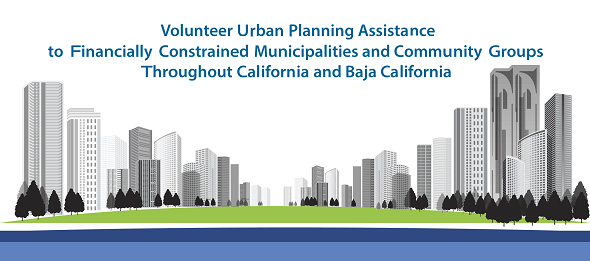
The American Planning Association (APA) California Chapter and Planner Emeritus Network (PEN) are pleased to offer a program that provides volunteer urban planning assistance to financially constrained municipalities and community groups throughout California and Baja California. Through the formation of a Community Planning Assistance Team (CPAT) consisting of experienced planners, allied professionals, and community experts, a dedicated team will work collaboratively with residents and community stakeholders to provide planning expertise and technical assistance. The program represents a professional and ethical commitment of APA California and PEN to foster community education, engagement, and empowerment and promote equitable, inclusive, healthy and sustainable California communities.
To suggest or discuss a potential community project: contact Hanson Hom, AICP, CPAT Coordinator, at [email protected] or submit a Community Request for Assistance Form. We will connect with you as soon as possible.

Program FAQs
What is the Origin of the Program?
APA California’s Community Assistance Program, launched in 2016, is patterned after a similar program created by the national American Planning Association in 1995. Watch this two-minute video below for a program overview.
https://www.youtube.com/embed/W2S7dGjyp3o
What Projects Are Suitable for Community Assistance
The goal of the program is to provide value-added planning expertise to challenged communities. Proposals are welcomed from any community or organization that do not have sufficient resources to hire a consultant firm to tackle a multi-faceted planning problem or issue. A CPAT can fill this gap by offering pro bono professional services tailored to the specific needs of the community. Assistance can take various forms, such as community education and facilitation, planning advice and insights, technical assistance, or planning analysis. Possible outcomes can be a vision plan, strategy for achieving community goals, action or implementation plan, concept vision for transforming a commercial district or neighborhood, economic development strategy, or collaborative planning framework to resolve local issues.
What is the Role of the CPAT?
A team leader with expertise that best meets the needs of the community project will be identified. A multidisciplinary team of volunteer professionals will be assembled to work closely with community leaders. The CPAT will develop a project schedule and define the deliverables and final product. The planning process typically includes significant involvement of local stakeholders and broad community outreach. In discussions with the community partner, the process can be structured as a charrette or a series of workshops or meetings. (For 2021, meetings are expected to be virtual.) The CPAT will provide the community with a final product (typically a report in electronic form) and it will be published on the APA California website.
How Can I Volunteer on a CPAT?
A CPAT provides a venue for creative community service for APA California members. While services are pro bono, participation may qualify for AICP credit. Each team is selected based on the expertise needed to address the local community’s planning issues. Team members engage with community representatives in a short but intensive planning process. If you are a member of the APA California and wish to volunteer your services, please complete the CPAT Volunteer Form.
How Are Projects Selected and Initiated?
Every request for assistance is carefully reviewed by a committee of APA California and PEN. The evaluation considers community need, potential positive impact, and community readiness in terms of local leadership and community support. Meritorious proposals are recommended to the APA California Board of Directors for approval.
An agreement is then executed that outlines the responsibilities and expectations of the community partner and APA California. Reimbursements and possible sponsors to cover expenses (e.g., transportation, food, accommodations, facilities, materials, and technology support) will be addressed if applicable.
CPAT Project Reports
Revitalization Strategy for Downtown Kingsberg
Downtown Oxnard Action Priorities
Hughson Downtown Revitalization Project
APA Affiliate Organizations
California Planning FoundationCalifornia Planning RoundtablePlanner Emeritus Network (PEN)
Upcoming Events
- Free Webinar: Hidden Pathways in Planning
- Oct 13, 2022
- Planning With, Not For: Inclusive & Community-Driven Planning in the Region — CM | 2.0
- West Sacramento Community Center, West Sacramento CA
